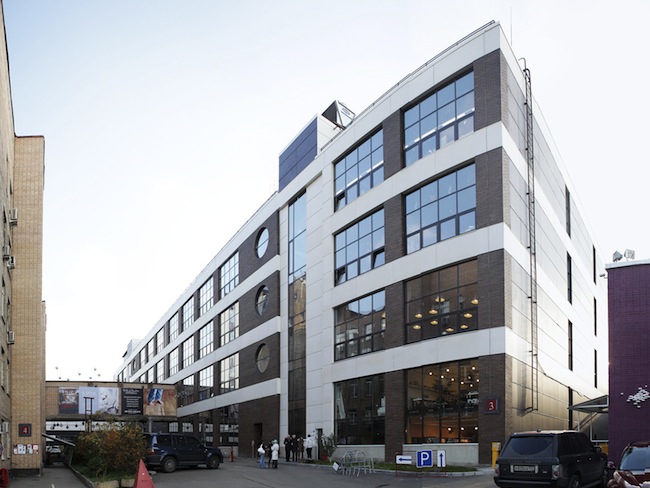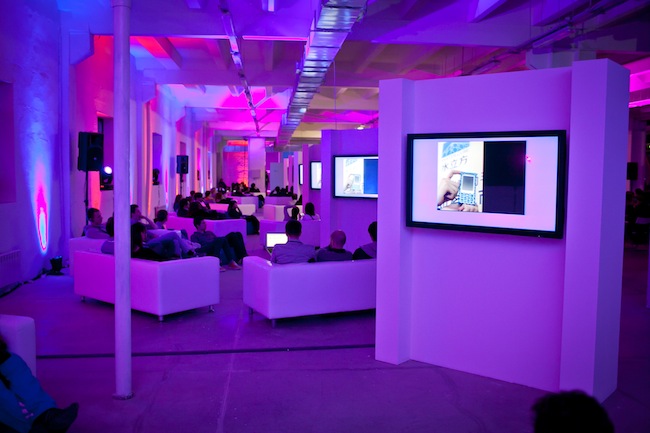
How Creative Quarters Can Survive
16/10/2012
Alina Saprykina is the artistic director of Artplay – a creative quarter and design center in Moscow – as well as a curator and initiator of various art projects. Saprykina was also closely associated with the founding of Dasha Zhukova's contemporary art center “Garage”, having organized among others one of the center's first corner-stone exhibitions that was dedicated to Ilya and Emilia Kabakov. The prestigious Russian art magazine, “Arthronika”, has placed Saprykina on their list of “50 Most Influential People in Russian Contemporary Art”. Saprykina was also awarded the “Caryatid” prize this year, which is given to women for their achievements in the field of contemporary art.
Established in 2003, Artplay was the first creative quarter in Moscow. It has changed its location twice, and is now housed in a one-time manometer factory, near the Kurskaya metro station, and right across the street from another notable object on Moscow's contemporary art scene – the Winzavod creative quarter.
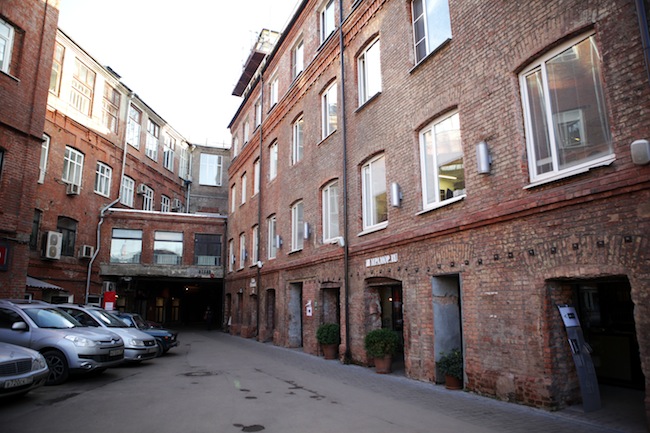
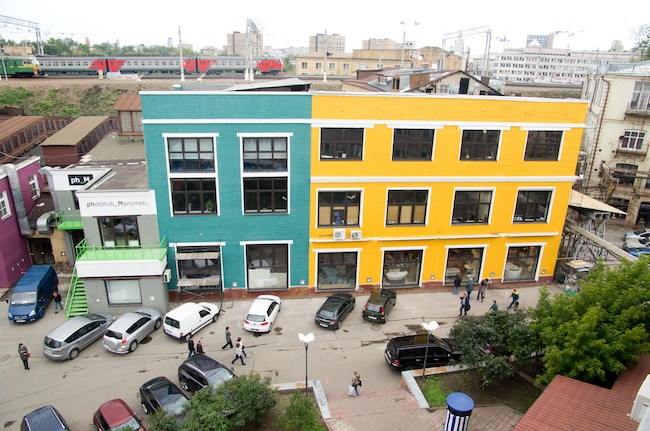
Artplay creative quater
Artplayis a grandiose, 75,000 square meter-large territory that contains, among other things, three exhibition halls (with a combined total of 8000 square meters), the British Higher School of Art and Design (with two more educational institutions soon opening), more than 300 showrooms, design and architectural offices, cafés, book stores, shops, a movie theater, a music club, a children's art studio, and the first ice-skating rink in Moscow to be located on a roof (at a size of 2500 square meters, it lies right on top of the British Higher School of Art and Design). It is a real city within a city – with its own streets and squares, permanent residents and guests, and a life that is not just going on, but virtually bursting at the seams. Last year, Artplay was home to the 4th Moscow Biennale, and this year the quarter had a record-breaking number of visitors during Moscow's “Museum Night” – 25,000 people in one night. It seems as if the only thing missing from making the place completely self-sustaining is a hotel. As it turns out, it's only a question of time until this last piece of the puzzle is put into place – such a project is already on the books for Artplay. But what makes Artplay unique, in comparison to other creative quarters in both Moscow and other global metropolises, is its endurance model, which is fundamentally based on a successful business concept that allows for both the development of the quarter and the existence of creative operations.
Alina Saprykina compares Artplay to New York's Soho and Berlin's Kreuzberg, adding that if those two areas are whole districts that have formed by themselves, then “we're trying to create something similar in our territory, but in miniature.”
Moscow joined the creative quarter movement rather late in the game, and Artplay could be said to be a pioneer in this field. Tell me, how did Artplay come about?
Artplay was created in 2003 as a private project that consisted of three lines of development – a furniture showroom, an architectural office, and exhibition activities. Our first gallery was only 600 sq. meters, and its cultural politics were in my hands. You could say that we both sold furniture and organized exhibitions and concerts, all in one place. But not long thereafter, the ownership of the space that we rented changed hands, and we had to look for a new home. The rest happened spontaneously. In 2003 we were given the opportunity to move into a part of the factory “Red Rose”, located in Khamovniki, an old industrial district; its atmosphere and daily proletarian life were vividly described by Tolstoy. When we arrived there for the first time, the feeling was indescribable – a very beautiful factory building, its oldest section having been built in 1905. A huge room – 10,000 sq. meters. It didn't look very large from the street, but inside, it expanded into the depths like a triangle. But when we went inside... I remember as if it were today – the girl that worked on the design of the gallery's at the time just stood and cried, it was so horrible... And it really did look bad – an abandoned factory in which nothing had happened for years. All of the windows were knocked out, the glass shards just lying there on the floor. We were literally swimming in garbage – there were boots, some sort of cables and all sorts of old industrial “reliquaries”... But our architect, who is currently also the director of Artplay, Sergey Desyatov, stood in the middle of it all and said: “Very cool”.

Opening ceremony of 4th Moscow Biennale
We understood that this was an opportunity to begin a new phase, and we took a risk. We took those 10,000 sq. meters. We kept a very small part for ourselves – one thousand sq. meters – for exhibitions and a furniture showroom, and rented out the rest. We had actually created a “self-organization” – something completely new for Moscow. The name “creative quarter” only came later. Much the same way that artists group together in squats, we decided to move into a huge factory not by ourselves, but as a big crowd. And everybody would be under one brand – thereby representing a unified space, common interests, and a tusovka [Rus. – a social and cultural get-together]. All creative quarters are based on a similar model, the only difference being in what makes up the core. In our case, architects were at the core. We invited twenty of the sharpest architecture offices in Moscow to come in under our roof: Yuri Grigoryan's Projekt Meganom, Boris Uborevich-Borovsky's UB Studio, Aleksei Ginzburg's office, Sergey Choban's studio (who was the curator of Russia's pavilion at this year's Venice Architecture Biennale), and others.
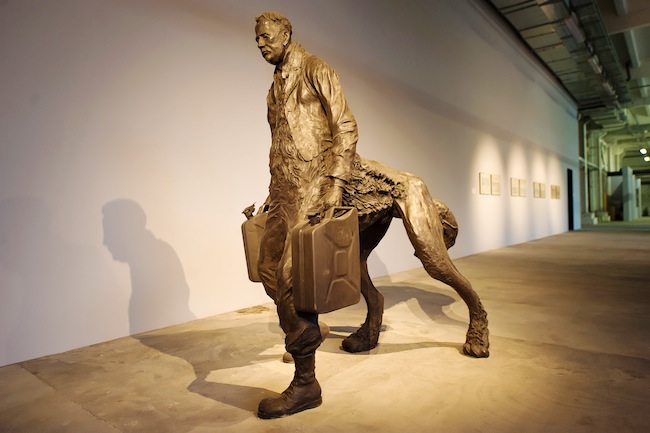
4th Moscow Biennale in Artplay space
Why did they come to us? First of all, we already had an architectural office of our own, so that the formation of the union being based on a foundation of architecture and design was, to a certain extent, just natural. For some, the favorable financial terms may have been the deciding factor [architects were a sort of anchor, and therefore space was rented out to them at a considerable discount – ed.], for others – the fun, party-like atmosphere and the opportunity to be together with respected architects. Shops selling furniture and other home and interior-related objects joined the architectural offices. From the start, the most important objectives were to create a synergy between the “game players” – architects and merchants, and to put together a cultural program that would garner interest from both the inhabitants of the quarter and their clients. In the beginning, we tried to do something that would be interesting to our patrons – architects and designers, and then we gradually invited representatives from other fields as well. We held exhibitions, auctions, and master classes; we hosted the photography biennale. Artplay was also the site of the release presentation for Zemfira's album, “Vendetta”.
That sounds unbelievable. Does that mean that your architects are on such friendly terms with one another that they're not even worry about being together in one place – where a client can impulsively, and easily, switch one firm for another?
You must remember that those were the “golden years”, when everybody had clients, and quite a few times the larger offices even deferred some projects to the smaller offices. There was enough work for everyone.
And when did the economic crisis start?
In a way, you could say it was providence – our rental agreement with “Red Rose” ended in 2008, and the owner decided not to renew the contract. That's actually a common occurrence in territories like these, and elsewhere in the world as well – artists and creative initiatives make them popular, rents rise, and the artists can't afford to stay anymore. Bankers and big business come in their place. [Currently, the “Red Rose” houses banks, the internet company Yandex, and real estate agencies – ed.] We had to look for a new space, which took quite a while, and consequently, our union partly dissolved. Some of them did join us later, but not everybody. But the main thing is that we saved ourselves and our concept, and we're continuing to develop it. And now, the area of Artplay is seven and a half times greater than it was at “Red Rose”. Here we have 75,000 sq. meters, or three Red Squares. Last year we hosted the 4th Moscow Art Biennale.
How would you describe your current feelings about Artplay?
The platform is the same. It revolves around design. At the foundation is the concept of business – the core is composed of architectural and design offices, and shops. Education joins very well this core – at first in the field of design, and now with architecture and film schools, too. Quite logically, this all grew out of our existing frame. Cultural activities are matter-of-course for this kind of territory. However, at Artplay, they are not part of the business program; they are possible only because we can afford it, which in turn, is thanks to the commercial framework at the basis of this project. This is how Artplay differs from other creative territories in Moscow. Garage, for instance, has an owner and investments, and it's a project that is directed and sponsored by these investments. Winzavod is similar – its director also sets the course. We, on the other hand, are a self-made project, the main goal of which is to ensure independence which, at the same time, means commercial self-sufficiency, along with functionality and the opportunity to develop.

From an architectural standpoint, both pre-revolutionary red bricks and soviet concrete coexist in this territory; the various buildings differ in height. It's interesting for us to conserve everything of value, to find a common denominator among the different times, styles and materials... The same could be said about the concept of Artplay. In addition, space is not rented out to just anybody who wants it, but only to those who fit in with the conceptual image of the quarter: design, architecture, art, fashion, film, various interdisciplinary projects dealing with both business and creative activities. Another essential element is that alongside individual development, there must also exist communication between all parties.
How did the first educational project come about – did the British Higher School of Art and Design find you, or did you find it?
They were looking for a location and, in a sense, it was just favorable happenstance. Right now, Artplay is in such a position that there is no lack of establishments wanting to get in. Many are in favor of unification, because it doesn't hinder positive competition. In addition, there's always something going on here – there are design offices all around, and students have different opportunities for gaining experience. In a way, they are in the epicenter; not on their own, but already in a defined context.
Do creative territories in Moscow receive State support?
The State support process has just started, and it is linked to changes in the city's cultural department, the head of which is now Sergey Kapkov. He was the one who initiated the changes in Gorky Park – this project gave him the opportunity to understand the importance of the local territory, as well as what the territory needed. The number of creative territories in Moscow is currently ever increasing – and in a good and proper manner, at that. They're territories in which it is comfortable to find yourself – they're like small towns, where “everything happens”, but they're surrounded by, shall we say... terrible Moscow. Kapkov's objective is to transfer the development model of these local quarters to the development of the whole city. To allow these places to spread out, not just continue to churn on in their own little corner; to foster mutual cooperation, and to integrate us into larger events. I felt it for the first time just this year, during Moscow City Days – a festival that has always been somehow cut-off from other processes. This year, the creative quarters were also invited to participate. In my opinion, the city's welcoming stance in these kinds of initiatives can only be lauded.
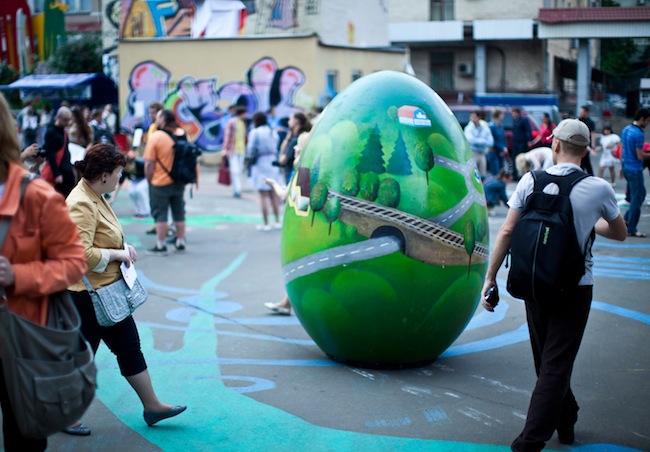
Museum Night in Artplay, 2012
How many creative quarters are there in Moscow right now, and how do they get along with one another?
There are five – Zil, Flacon, Winzavod, Krasnij Oktjabr, and us... In such a huge city as Moscow, with a population of 15-20 million, I think that's an average number. In addition, each of these quarters can hold from five to tens of thousands of people. The number of patrons of cultural projects in Moscow is about 150,000 people. That's not a lot, nor a little; you just have to be aware that the number of people interested in contemporary art processes is limited. For example, this was the exact number of people that visited the month-long 3rd Moscow Biennale, when it was held at “Garage”. But, since alongside art and cultural projects, Artplay also deals with retail sales, our prospective audience is larger, practically without limits. Winzavod, on the other hand, is based upon a completely different model, so there is no talk of competition here, but rather a need to understand and realize these differences, so that we can encourage development and mutual assistance. Of course, if we'll be the same, either one will take over the other, or there will be a consolidation. When Winzavod organized a comic festival, they created a special program for students at Artplay.
This summer you executed a practically utopian coalition project – the design exhibition, Student Art Prom 2012 – an assembling of the highly competitive Moscow art schools, all under one roof.
Yes, that was my idea. The experiment itself was interesting to me – assembling all of the Moscow art schools into one territory. (They are very diverse from one another, and there is such outright animosity that some don't even accept the others as viable institutions of education.) The project was a success – diploma works by degree candidates, from all of the most notable Moscow art schools, were put on display within 3000 sq. meters of space. Rodchenko School of Photography, Stroganoff Art Academy, the Strelka Institute, etc. In addition, alongside the exhibition, we held various lectures and master classes. This project proved once again that unification is possible – if you can find a central element that is both powerful enough and neutral. I must admit that I made considerable use of my cultural quarter experience, which confirms how important it is to place yourself and your cooperative partners on an even playing field – and not keep trying to put yourself above the others. On the one hand, they are conscious of the fact that you are the director, but on an emotional level, you are simply the manager. I've come to understand that for many people (at least “our people” – others may experience this at higher or lesser degrees), this system of feelings is decisively quintessential.
What are the politics surrounding the exhibitions at Artplay?
Maybe due to the fact that we were the first creative quarter, I have this ongoing feeling of being unfulfilled. Young artists tend to have a similar thing. We had a rental contract at “Red Rose”; that ended, and we moved here – and everything is still in process. We're not yet ready, yet we're not unfinished... And that creates a constant run on development; it doesn't allow for stopping, and it makes us look to the future. Which is why in our exhibition program, we try to bring attention to not only artists, but especially to new projects. Because I can't get rid of the feeling that the phenomenon that we currently call contemporary art could, quite soon, change in a completely unpredictable direction. Art will no longer be created by just artists – anyone will be able to do art. In our case, these are designers, students – overwhelmingly non-artists – just regular people who, during the Moscow City Days, came and painted over the surrounds of Kurskaya [railway] Station. Not the usual classification – visual art, performance, video art, public art, etc., but something completely unexpected. There are not many places in Moscow that are ready for an experiment; we are one of the few. At Artplay, we host media activity projects, as well as projects with crazy artists whom no one else wants to take on – we will work with them. In a sense, that is our position – to be the platform for such experiments; to see what the future of art might be like. To give any sort of artistic expression – which may only be just be forming, but has promising potential – the opportunity to manifest itself. We can afford to do this, because we have the space in which to try it out, and then, often enough, the most unbelievable things happen. Of course, as always, some things happen, some don't. But for those for whom things do work out, we've given them the opportunity to be. Since there are three art schools in the territory of Artplay, we have a concentration of more than 3000 students here – and the course of the new art is being carved out here organically. Very often, young people bring their own works. The previously-mentioned student exhibition came about through such a process – the British Higher School of Art and Design wanted to hold their graduate exhibition, and we started to think – who else is in the city, let's try to get everyone together and make a combined exhibition that would be interesting for everybody.
Of course, my assignment is to entice various interesting initiatives into holding their events here, like the 4th Moscow Art Biennale last year, and this year's events commemorating the one thousand-year anniversary of the relationship between Germany and Russia, and so on. It is very crucial that, alongside these experiments and new art, very high-level art events and museum projects take place here as well. So that there is a balance.
This year you received the “Caryatid” prize – what does that mean to you?
The award was created in the honor of Olga Lopukhova (1958-2009), a very special person on the Russian art stage. Olga was a curator, initiator of many great art projects, and a co-author. She was one of the curators for Russia's pavilion at the 51st Venice Biennale, the executive director of the Moscow International Biennale of Young Art, the producer of the visual art competition “Innovation”, the curator for the Warhol Connections exhibition during Warhol Week in Moscow, and on and on. Her last large project was the cultural center ARTStrelka, which she directed until 2009. There are very few people like her in Moscow, and she has left a very great impression on me. We tried to bring about a project together, but unfortunately, that didn't happen. She passed on. That which she did, and how she did it, was something new for Moscow, and along with that – a very important landmark. And, since this prize is in her honor, and in honor of other women who have had an important impact on contemporary art processes in Russia, it is very important to me. In effect, it makes it my duty to continue what has been begun; to do something in honor of Olga.
